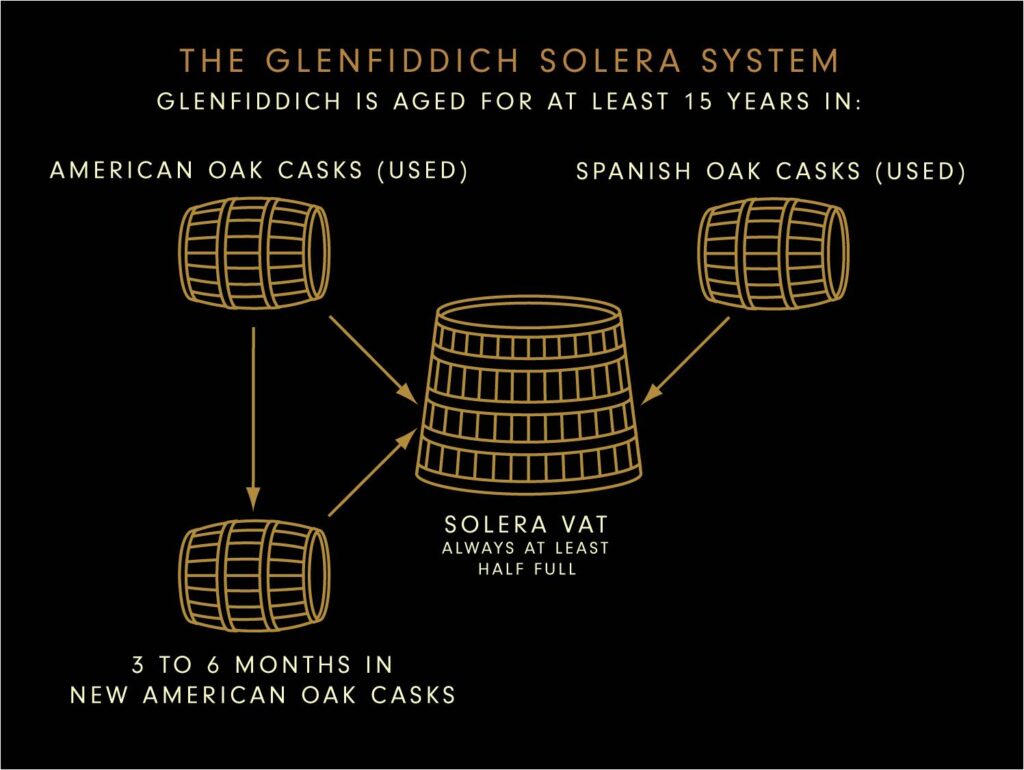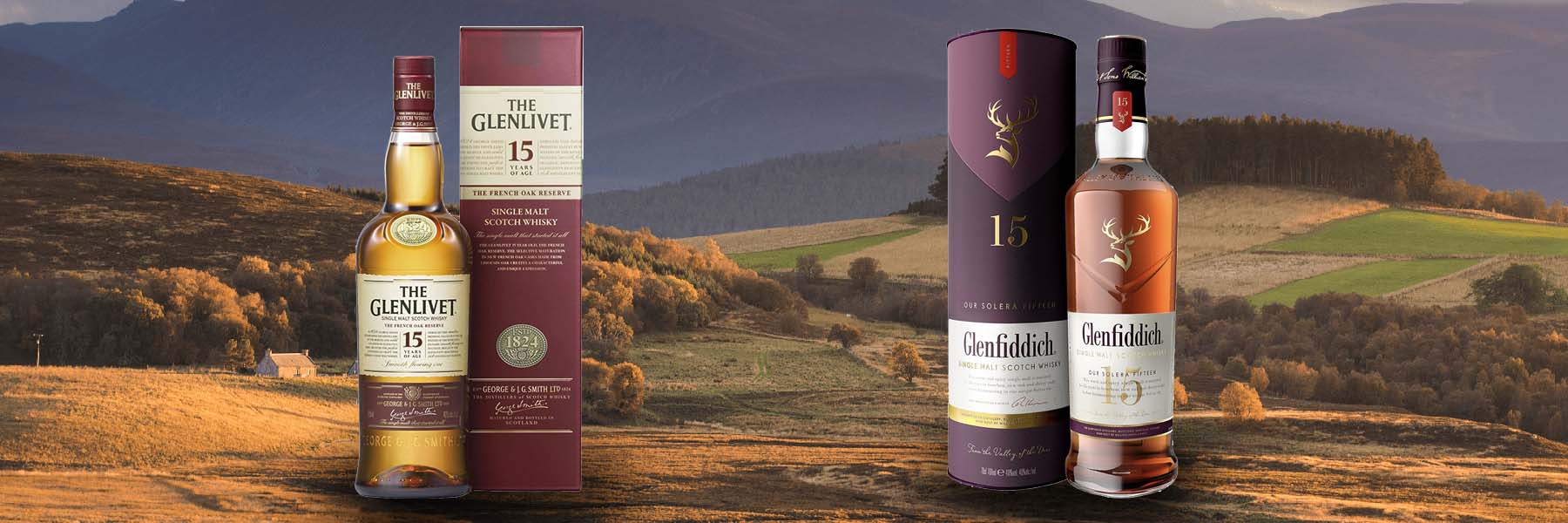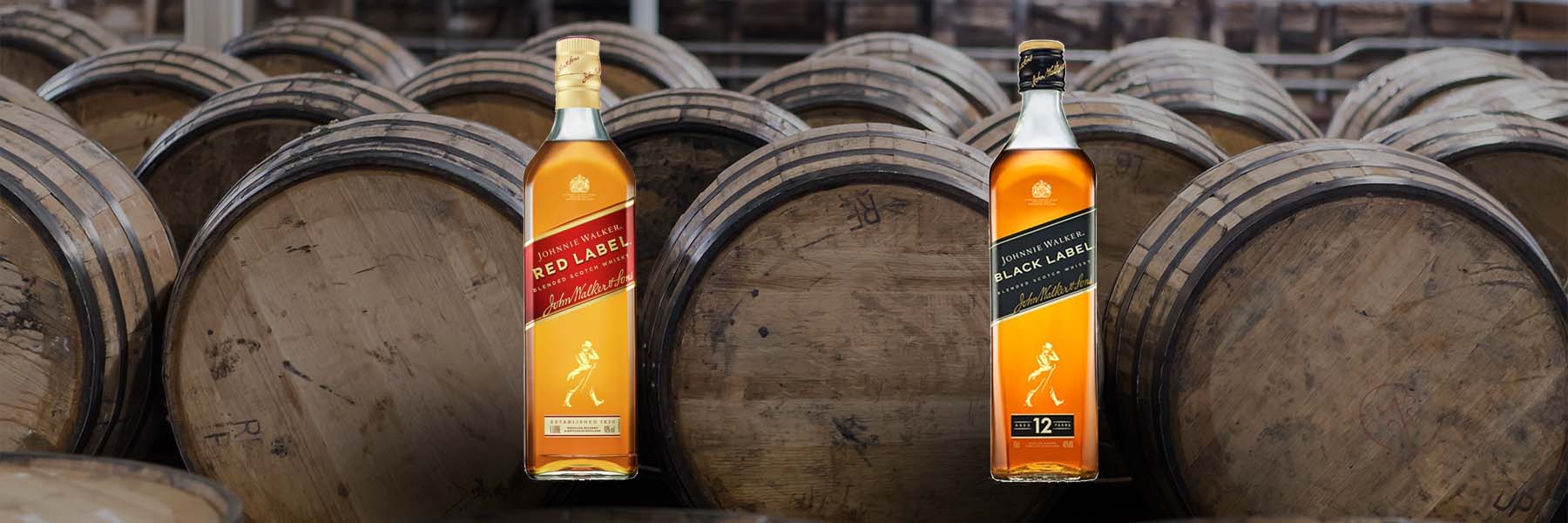Glenlivet 15 vs Glenfiddich 15 | Which one is best?
Last updated on August 13th, 2024
For the whisky aficionado who is looking for that perfect single malt, it can be challenging to find exactly what you are searching for.
Glenlivet 15 and Glenfiddich 15 have been two of the most popular labels around – but which one should a discerning drinker choose?
In this side-by-side comparison, we’ll explore each brand’s respective fifteen year old expression to see how they compare in terms of flavour complexity, aroma profile and finish. Whether you’re an experienced whisky enthusiast on your journey through Scotland’s golden nectar; let’s compare Glenlivet 15 vs Glenfiddich 15.
Glenlivet 15 vs Glenfiddich 15: History of the two whiskies
The Glenlivet 15 is an iconic single malt Scotch whisky from one of Scotland’s oldest and most celebrated distilleries. Situated in the idyllic Speyside region of Scotland, this true classic was released as part of their core range back in 2015 – offering smoothness and elegance with every sip delivered straight to your glass.
The Glenfiddich 15 was first released in 1987, and was the first in a series of age-statement whiskies from the Glenfiddich distillery. It was the first single malt whisky to be matured in both traditional oak and sherry casks, creating a unique flavor that quickly became wildly popular. The Glenfiddich 15 has become a staple in the whisky world, winning numerous awards and praised by whisky connoisseurs around the world.
Speyside, Scotland is home to some of the world’s top-rated whiskies – The Glenlivet and Glenfiddich. These two labels are just a stone’s throw away from each other (30km) in this beautiful region known for its ideal environment that produces whisky with unique sweet and fruity notes loved by connoisseurs across the globe. If you’re looking for an authentic Speyside experience, look no further than these iconic bottles!
Initial comparison
- Glenfiddich 15 and Glenlivet 15 are both Speyside single malt whiskies.
- Glenlivet is fermented for 50 hours
- Glenfiddich is fermented slightly longer, ranging between 48-72 hours
- Both whiskies use traditional pot still, double distillation.
- Glenlivet 15 is part matured in traditional ex-bourbon casks and specially coopered French Limousin oak casks prior to being ‘married’ together.
- Glenfiddich 15 is part matured in European, American, and New American oak casks, mellowed in their ‘Solera’ vat prior to marriage in Portuguese oak tuns.
Let’s explore these whiskies in greater detail to get a better understanding of their distillery characters, distillation, and maturation methods.

Glenlivet 15 tasting notes
Nose: Rich, oaked, mildly fruity resinous wood with a well-balanced acidity.
Palate: Thick oak, cloves, cinnamon, vanilla, and hints of honey.
Finish: Long, with a peppery note, caramel, butterscotch, wood, and ash.

Glenfiddich 15 tasting notes
Nose: Sherry, citrus – orange in particular, dry wood, slight smoke.
Palate: Medium, raisins, sherry, fruitcake, spices, sweetness.
Finish: Candied fruits, spices, raisins, Christmas pudding, oak
Glenfiddich 15 year old whisky is an iconic single malt scotch that has been crafted using the same timeless methods for more than a century. This whisky is aged in Spanish Oloroso sherry casks for fifteen years, infusing Glenfiddich with a unique flavour and character.
On the nose, Glenfiddich 15 reveals a bouquet of dried fruit, toasted oak, and dark chocolate, with subtle hints of smoke as well.
On the palate, Glenfiddich 15 is incredibly smooth and balanced, with sweet notes of apple and pear, as well as a slight smokiness from its sherry cask aging. There is also an underlying complexity with flavours of toffee and spice adding further depth to Glenfiddich’s signature character.
In addition to its notable flavour profile, Glenfiddich 15 also has an unmistakable golden hue that adds further appeal to this classic single malt scotch. Glenfiddich 15 year old is best enjoyed neat or on the rocks so that you can fully appreciate its robust flavours without any mixers or ice diluting them.
The finish is long, leaving you with a smooth lingering sweetness on the tongue that makes Glenfiddich 15 one of the most sought-after single malts around the world.
The quality and refinement of Glenfiddich 15 year old whisky makes it perfect for special occasions or to simply enjoy at home after a long day at work. Its complex yet mellow flavour profile will leave no doubt in your mind why Glenfiddich continues to be one of the premier Scotch whiskies in the world today.
For an entrée that pairs perfectly with Glenfiddich whisky, try fatty meats such as steak, lamb, or pork. Oily fish like salmon or tuna also pair nicely. For a more unique experience, try sushi or sashimi, or even duck. To round out your meal, try a tasty cheese such as goat cheese or brie. For dessert, try fresh fruit, baked pears, toffee pudding, strawberries and cream, or any other sweet to compliment the whisky.
Is Glenfiddich 15 a good whisky?
Yes, Glenfiddich 15 is an excellent whisky that should not be overlooked. Its unmistakable golden hue and complex yet mellow flavour profile set it apart from other single malt whiskies on the market. Its fifteen years of aging in Spanish Oloroso sherry casks give Glenfiddich a unique and bold character.
Glenlivet 15 vs Glenfiddich 15 Comparison
| Glenlivet 15 vs Glenfiddich 15 | Glenlivet 15 | Glenfiddich 15 |
| Colour | Deep, intense gold | Golden with a red hue |
| Nose | Rich, oaked, mildly fruity resinous wood with a well-balanced acidity | Sherry, citrus – orange in particular, dry wood, slight smoke |
| Palate | Thick oak, cloves, cinnamon, vanilla, and hints of honey | Medium, raisins, sherry, fruitcake, spices, sweetness |
| Finish | Long, with a peppery note, butterscotch, wood, and ash | Candied fruits, spices, raisins, Christmas pudding, oak |
| Rating | 8.2/10 | 7.9/10 |
| Age | 15 years | 15 years |
| Region | Speyside | Speyside |
| ABV | 40% | 40% (51% Distillery Edition) |
| Classification | ||
| Cask | American and European | European |
| Chill filtered | Yes | Yes (No at Distillery Edition) |
| Price (USD/GBP) | $51/ £41 | $50/£40 |
Final thoughts: Glenlivet 15 vs Glenfiddich 15
The epic clash between Glenlivet 15 and Glenfiddich 15 is common debate among whisky connoisseurs. Both expressions boast intricate and balanced flavour profiles that make them ideal choices for novices who’re looking for a mid-level single malt whisky.
For many who enjoy bolder flavours more suited to fireside sipping, The Glenlivet 15 serves up some warmth – smoky maltiness combined with dark chocolate hints promises a game-changing dram that will linger on the palate long after your last sip!
The Glenfiddich 15 offers a sweet and mellow experience with its honey, vanilla and tropical fruit notes. Its lightness makes it an easy-drinking whisky for those looking for something smooth.
Both whiskies are excellent options for whisky lovers, and the choice ultimately comes down to personal preference. Those looking for a sweeter, more mellow whisky should opt for the Glenfiddich 15, while those looking for something bolder and more full-bodied should go with the Glenlivet 15.
Down the rabbit hole?
If you are a keen Speyside whisky enthusiast you may also enjoy our reviews of: Glenlivet vs Glenfiddich 12, Glenlivet 18 vs Glenfiddich 18 and Glenlivet vs Glenfiddich vs Glenmorangie.

Making Glenlivet 15
Getting their Grain
The barley used by Glenlivet is sourced from neighbouring Crisp Maltings plant based in Portgordon, Buckie. There, they soak the grain in water several times to initiate germination where rootlets develop, thus making the barley’s starches more accessible. To halt germination, they then kiln dry the barley using warm air. Instead of using peat, this neutral heat source allow the grain’s full flavour to come though in the whisky.
Mashing
Delivered to the Glenlivet distillery in Ballindalloch, the malted barley is then ground into grist (a coarse flour mixture) using a motorised roller mill. The grist is then added to their large modernised full-lauter tuns and mixed with hot water for mashing. This process extracts and converts the barley’s starches into a sugary liquid called wort. With repeated draining and batches of hot water, the sugar extraction is maximised from the grain.
Fermentation
Once cool, the sugary wort liquid is then transferred to the distillery’s large Oregon Pine washbacks. These large cylindrical vats are used to ferment the wort with the addition of yeast. Lasting around 50 hours, the yeast feeds on the sugars within the wort converting it into a basic 9% ABV beer called wash.
1st Distillation
To extract the alcohol from the wash, it is transferred to the first of two pot stills. The liquid is slowly heated from the bottom which begins to boil the beer. Alcohol vapours begin to evaporate, making their way out the still-neck, into a condenser which cools the vapours back into liquid form known as low wines. This liquid has an ABV of around 30%.
2nd Distillation
The low wines are then transferred to the second pot still known as the spirit still. Once again, the liquid is heated so that the stronger alcoholic vapours can be collected. This produces a much stronger distillate of around 70% ABV which is called new make spirit which is then ready for maturation.
Maturation
The Glenlivet 15 is matured in a combination of American and European oak casks
The aging process is divided into three stages, primarily in barrels previously used to store bourbon whisky, which are constructed from American white oak.
A smaller portion is then placed in ex-sherry casks, also made from American white oak.
The unique and final part of aging is done in newly coopered casks made of French Limousine oak which is sourced from the Dordogne region. This timber has a low density which allows the spirit to penetrate the wooden staves resulting in a refined spiciness.
Making Glenfiddich 15

The malting process begins by steeping the barley in water for two to three days. This allows the barley to absorb moisture and begin to germinate. The barley is then spread out on the malting floor where it germinates for about five days. During this process, enzymes are activated which convert the starches in the barley into sugars.
After the malting process is complete, the barley is ground into a coarse flour known as “grist.” The grist is then mixed with hot water in a mash tun, which is a large vessel. The mixture is stirred and heated to extract the sugars from the grist. The resulting liquid, known as “wort,” is then drained off and fermented.
The wort is transferred to fermentation tanks where yeast is added. The yeast transforms the sugar from the wort into alcohol and carbon dioxide. The fermented liquid, called “wash,” is then transferred to a still. Then it’s heated to vaporize the alcohol in the wash, leaving behind the water and other impurities. The vaporized alcohol then passes through a condenser where it is cooled and converted back into liquid form. This liquid is known as “new make spirit.”
Glenfiddich 15 is aged for a minimum of 15 years in a combination of bourbon and Sherry casks. It is then finished in a unique Solera vat, which is a large oak vat that is never completely emptied and always contains a small amount of whisky from previous years. This process creates a complex and smooth whisky that has a unique flavor profile.
At Glenfiddich, an in-house stillman carefully cuts the whisky by hand, and special cooperages take care of the casks right on site.
FAQs
Are Glenlivet and Glenfiddich good Scotch whiskies?
Yes, Glenfiddich and Glenlivet are both excellent Scotch whiskies. They are two of the most popular single malt Scotch whiskies in the world and are highly rated by whisky connoisseurs.
They are often a popular choice for whisky enthusiasts, thanks to Glenlivet’s smooth and mellow and the Glenfiddich’s satisfyingly rich, sweet finish.
They are an important part of Scotland’s whisky heritage and continues to be favorites among whisky drinkers.
Which is better Glenfiddich or Glenlivet?
This is a matter of personal preference and cannot be definitively answered. Both Glenlivet and Glenfiddich are highly-respected single malt Scotch whiskies, and both have a wide variety of expressions that appeal to different palates. Ultimately, it is up to the individual to decide which whisky they pick. If you prefer an oaky flavor, then Glenfiddich is the ideal selection for you. On the other hand, if you are looking for a maltier aroma, then Glenlivet is the better choice.
Why are Glenlivet and Glenfiddich so expensive?
Glenlivet and Glenfiddich are two of the most popular Scotch whiskies and are known for their high quality. They are expensive because of the long production process, which includes aging in oak barrels for a minimum of three years. Single malt whisky is widely considered to be the pinnacle of the whisky-making craft. It takes years of experience and knowledge to produce a high-quality single malt whisky.
The distilleries also use the finest ingredients and traditional production methods, which adds to their cost. Furthermore, their popularity and limited availability contribute to their price.
What is the difference between Glenfiddich and Glenlivet Scotch?
Glenfiddich and Glenlivet are both iconic single malt Scotch whiskies, but they have some distinct differences. Glenfiddich is aged in Spanish Oloroso sherry casks for fifteen years, while Glenlivet is aged in ex-bourbon barrels for at least 15 years. Glenfiddich has a of dried fruit, toasted oak, and dark chocolate, with subtle hints of smoke. Glenlivet has a nose of fresh fruits and honey with an underlying spice.
Glenfiddich is smoother and mellower than Glenlivet, with sweet notes of apple and pear on the palate as well as a slight smokiness from its sherry cask aging. Glenlivet is more complex than Glenfiddich, with flavours of toffee and spice adding further depth to its signature character. Both whiskies are excellent drams that should not be missed, but if you are looking for a smooth and mellow single malt then Glenfiddich is the better option while if you are looking for something more complex then Glenlivet is the way to go.








